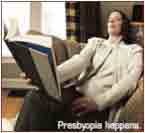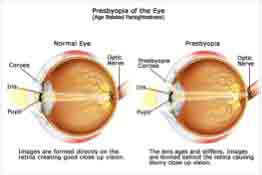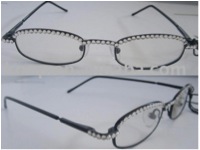|
Presbyopea and AgingCan Presbyopea be Prevented?By Michelle Botes age-well.org > eye care > presbyopea and aging Ever noticed how people move their reading material away from their eyes in order to be able to read or suddenly scurrying for their reading glasses in order to look at a menu? This is due to one of the most common age-related problems which exists. What is Presbyopea?
This age related condition, called presbyopia, will affect everybody from around the age of 45 onward. Even if you have never had vision problems, you will be affected by presbyopia. So it is in your interests to learn all you can about presbyopea and aging, so that you can stay updated on any new technologies and treatments which come available to treat the condition. In order for the eye to focus on small or objects close by, it needs to change shape or length (elasticity). As you age, the eye slowly starts to lose its elasticity, causing a person to have difficulty in focusing on objects close at hand. The origin of the word presbyopia is from the Greek “presby” and “ops” meaning “old eye”. Causes and symptoms of presbyopia
As we age, the lens in the eye slowly starts to harden and the muscles around the eye starts getting weaker. This causes light to focus behind the retina instead of on it, causing blurred vision of close up objects or reading material. Unfortunately, there are no generally recognized preventative measures to take in order to delay or prevent the onset of this condition. You will notice the onset of this disease by your inability to focus on small objects or objects that are close by such as reading or working on a computer. The most common symptoms of presbyopea and aging, include:
TreatmentThere is no scientifically proven cure available for presbyopea and aging, but this condition can be successfully treated with various methods. Glasses and contact lenses 
In most cases, a pair of glasses with either bifocal or trifocal lenses will be sufficient. Bifocals are glasses where the top of the lens is used to treat other sight problems and the bottom used for reading. Trifocals: which have three different points of focus. People who can see well at far distances without glasses can usually get by with a pair of over the counter reading glasses (magnifiers), available in different strengths. Monovision can be used to correct presbyopia, where one eye wears a distance prescription lens and the other eye wears a prescription lens for near vision. The brain eventually learns to favour the one eye over the other in order to focus on different objects. However, some sufferers complain of a loss of depth perception with this method. Surgical methods LASIK monovision is a laser therapy treatment to instill monovision. This eliminates the use of glasses or contact lenses for monovision. Conductive Keratoplasty (CK) surgery monovision is a surgical procedure where the ophthalmologist uses a probe, delivering radiofrequency energy on the cornea in order to change the surface of the cornea to induce monovision. This also eliminates the wearing of glasses or contact lenses, but the effects of this surgery is not long lasting. Intraoccular lens implants (IOL) where a new, more elastic lens is implanted, the patient would be able to have cleared vision. This surgery is usually done after cataract surgery is completed. There are numerous other surgical methods currently in trial phase. Some of the methods currently being tested includes a procedure where a highly elastic gel is injected into the eye in order to replace the natural lens, hoping that it will result in new, more elastic lens. Other trials where laser surgery could be used to increase flexibility in the lens are also underway. Only time will tell if these will be effective.
Alternative Treatments Probably many of us have seen publicity or read reports that it is possible to prevent or even reverse the problems of aging eyes, to a certain extent, through a series of eye exercises, often supplemented by taking minerals and vitamins. In order to benefit from the method it is necessary for your your brain and eyes to work together and these exercise programs are designed to facilitate this and to remove the rigidity and lack of flexibility of the eye muscles and lenses which has come about through aging. These are new methods which have not yet been scientifically proven through research. However, there are numerous patients who swear by these methods and who testify that these methods have meant that they no longer need to wear corrective glasses. One method which may be of interest is the We will endeavor to bring you further information about the best of these alternative treatments as this becomes available. In the meantime, if you find yourself not being able to focus while reading, visit your eye care specialist for a prescription. By leaving it too late, your deteriorated vision could start interfering with your daily activities. Chances are you only need a pair of reading glasses to start off with. Sources of InformationText about presbyopea and aging: Pubmed Health; All about vision; Medicine Plus; National Institute of Health; GP Contact Lenses; Illinois Eye and Ear Infirmary. Pictures on about presbyopea and aging:Glasses; Eye; Presbyopia Happens age-well.org > eye care > presbyopea and aging Top of presbyopea |
Translate this Site

Search this Site
Care For Your Eyes
List of Eye Conditions
Subscribe to Our E-NewsOther Conditions
Develop Smart Habits
|
|||||||||||||||||||||||||||||||||||||||||||||||||||||
|
|
|||||||||||||||||||||||||||||||||||||||||||||||||||||






